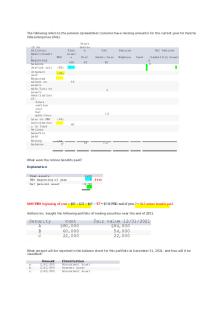Pension vs rrsp discussion PDF

| Title | Pension vs rrsp discussion |
|---|---|
| Course | Compensation and Benefits |
| Institution | Sheridan College |
| Pages | 2 |
| File Size | 94.2 KB |
| File Type | |
| Total Downloads | 82 |
| Total Views | 125 |
Summary
online class discussions and exercises...
Description
PENSION
RRSP
1. A Registered Pension Plan is an arrangement by an employer or a union that provides pensions to retired employees through periodic payments. Employer will put the money in the account prior to deducting taxes.
1. RRSP is an individual retirement savings plan. It can be established by any Canadian taxpayer who is registered with CRA. In practical terms, it is an investment account that you open with the financial institution of your choice and to which you or your spouse can contribute
2. Pension is guided under pension law.
2. RRSP is administered under the income tax act.
3. The plan is managed by a financial institution chosen by the employer, the union or both.
3. The RRSP account can be managed directly by you or by a hired financial institution who manages it for you.
4. Pension plans mainly pf 2 types -Defined benefit or defined contribution plans.
4. RRSP can be group RRSP or individual RRSP, can be locked-in or open.
5. Pensions can either be contributory, with employees required to make an annual contribution to the plan, or noncontributory, where employees make no contribution to the plan. Employers have to contribute.
5. Employees have to contribute but Contributions by the employer are not mandatory.
6. Rules around withdrawal of pension funds by the employee are more restrictive and employees cannot withdraw while they are working.
6. Withdrawals can be made at any time — you do not have to wait until retirement.
7. The income earned by the plan is not taxable and you are not required to report it. However, when you retire and begin to receive benefits from the plan, you will then need to include these payments in your income for the year when they are received.
7. Using your RRSP, you can invest in a large number of financial products such as from term deposits, mutual funds, stocks and bonds. Any income the RRSP earns from these investments is exempt from tax as long as the funds remain in the RRSP account. However, you must pay taxes whenever you make withdrawals from the plan.
8. No adjustments are allowed with spousal contributions.
8. Income splitting is available through spousal contributions. You can contribute to your spouse’s RRSP and vice versa.
9. Employer contribution to pension fund is not treated as taxable benefit to employee.
9. Employer contributions to RRSP are treated as taxable benefit to employee.
10. Defined benefit RPPs typically don’t have contribution limits. 11. An RPP plan comes with guidance on an appropriate retirement age when the disbursements can be made.
12. Defined benefits plan give you guaranteed return
10. Contributions to RRSPs above the limit can be applied to retirement savings in future years. 11. you are required to stop contributing to an RRSP at age 71, at which time you must either close the account and pay all the taxes owed or convert it to a Registered Retirement Investment Fund. 12. No surety on what you may receive.
Similarities between RPPs and RRSPs 1. 2. 3. 4. 5. 6. 7.
Both are retirement plans Both need to be registered with CRA Both are Tax-deferred savings- Both RPPs and RRSPs allow you to put away money tax-deferred. You have to pay taxes on both when you take money out- WITHDRAWALS ARE TAXABLE Both are contributory either by employer or employee or both Both Contributions are deductible from income when filing taxes.
Both are non- mandatory forms of retirement benefits provided by the employer....
Similar Free PDFs

Pension vs rrsp discussion
- 2 Pages

state pension questions
- 7 Pages

Practice ACC 3100 Pension
- 8 Pages

AFA Pension Leases Seminar
- 4 Pages

Week 4 Discussion - CSF vs RMF
- 2 Pages

SSS Law-Reviewer Pension
- 12 Pages

Law Pension ACT 766
- 76 Pages

DEM. Fijacion DE Pension Alimenticia
- 11 Pages
Popular Institutions
- Tinajero National High School - Annex
- Politeknik Caltex Riau
- Yokohama City University
- SGT University
- University of Al-Qadisiyah
- Divine Word College of Vigan
- Techniek College Rotterdam
- Universidade de Santiago
- Universiti Teknologi MARA Cawangan Johor Kampus Pasir Gudang
- Poltekkes Kemenkes Yogyakarta
- Baguio City National High School
- Colegio san marcos
- preparatoria uno
- Centro de Bachillerato Tecnológico Industrial y de Servicios No. 107
- Dalian Maritime University
- Quang Trung Secondary School
- Colegio Tecnológico en Informática
- Corporación Regional de Educación Superior
- Grupo CEDVA
- Dar Al Uloom University
- Centro de Estudios Preuniversitarios de la Universidad Nacional de Ingeniería
- 上智大学
- Aakash International School, Nuna Majara
- San Felipe Neri Catholic School
- Kang Chiao International School - New Taipei City
- Misamis Occidental National High School
- Institución Educativa Escuela Normal Juan Ladrilleros
- Kolehiyo ng Pantukan
- Batanes State College
- Instituto Continental
- Sekolah Menengah Kejuruan Kesehatan Kaltara (Tarakan)
- Colegio de La Inmaculada Concepcion - Cebu







